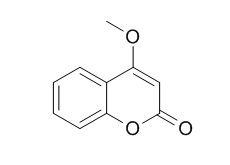4-Methoxycoumarine
4-Methoxycoumarin has antitumour effects.
Inquire / Order:
manager@chemfaces.com
Technical Inquiries:
service@chemfaces.com
Tel:
+86-27-84237783
Fax:
+86-27-84254680
Address:
1 Building, No. 83, CheCheng Rd., Wuhan Economic and Technological Development Zone, Wuhan, Hubei 430056, PRC
Providing storage is as stated on the product vial and the vial is kept tightly sealed, the product can be stored for up to
24 months(2-8C).
Wherever possible, you should prepare and use solutions on the same day. However, if you need to make up stock solutions in advance, we recommend that you store the solution as aliquots in tightly sealed vials at -20C. Generally, these will be useable for up to two weeks. Before use, and prior to opening the vial we recommend that you allow your product to equilibrate to room temperature for at least 1 hour.
Need more advice on solubility, usage and handling? Please email to: service@chemfaces.com
The packaging of the product may have turned upside down during transportation, resulting in the natural compounds adhering to the neck or cap of the vial. take the vial out of its packaging and gently shake to let the compounds fall to the bottom of the vial. for liquid products, centrifuge at 200-500 RPM to gather the liquid at the bottom of the vial. try to avoid loss or contamination during handling.
Faculty of Chem. & Nat. Resource Eng.2014, 62
J of Ana. Chem.2019, 74(11):1113-1121
Front Mol Neurosci.2023, 15:1083189.
Microchemical Journal2023, 194:109249
J Mol Med (Berl).2018, 96(7):661-672
Nutrients.2021, 13(1):254.
Journal of Third Military Medical University2018, 40(12):1073-1078
Foods.2022, 11(6):882.
Int J Mol Sci.2019, 20(9):E2244
VNU Journal of Science2023, No. 20.
Related and Featured Products
Melanoma Research, 1999, 9(3):243-248.
Cytostatic activity of coumarin metabolites and derivatives in the B16-F10 murine melanoma cell line.[Reference:
WebLink]
Coumarin has antitumour effects in vivo and cytostatic effects in vitro. Its half-life in humans is short (1-1.5 h) and the monohydroxylated biotransformation products have significantly longer half-lives. One or several of these products may thus be responsible for the antitumoral effects.
METHODS AND RESULTS:
We have assayed the in vitro cytostatic activity of five monohydroxylated coumarins (3-, 4-, 6-, 7- and 8-monohydroxycoumarin), their acetates and methyl-ethers. Murine melanoma cells (cell line B16-F10) and murine fibroblasts (B82) were exposed to the test compounds at concentrations between 10 and 160 microg/ml. The cytostatic effects were estimated by reduction of the tetrazolium dye MTT. In the melanoma cells, some of the compounds inhibited growth after exposure for 1 day. In contrast, coumarin inhibited growth to a smaller extent, and only after exposure for 3 days. The most active compounds (3-acetoxycoumarin, 4-methoxycoumarin(4-Methoxycoumarine) and 6-hydroxycoumarin), as well as coumarin, were also assayed in murine fibroblasts.
CONCLUSIONS:
The cytostatic effects of 4-methoxycoumarin(4-Methoxycoumarine) and 6-hydroxycoumarin were less pronounced in fibroblasts than in melanoma cells. Our observations suggest that these compounds may have a greater therapeutic margin.



